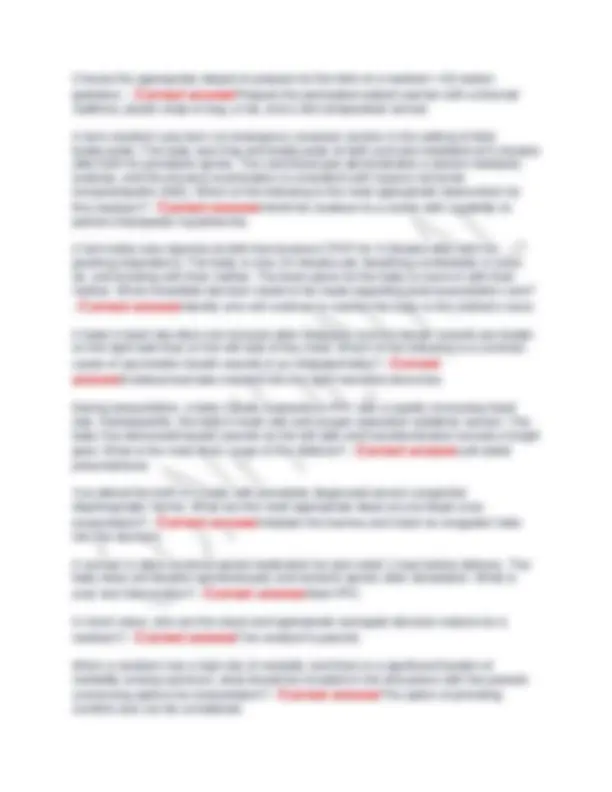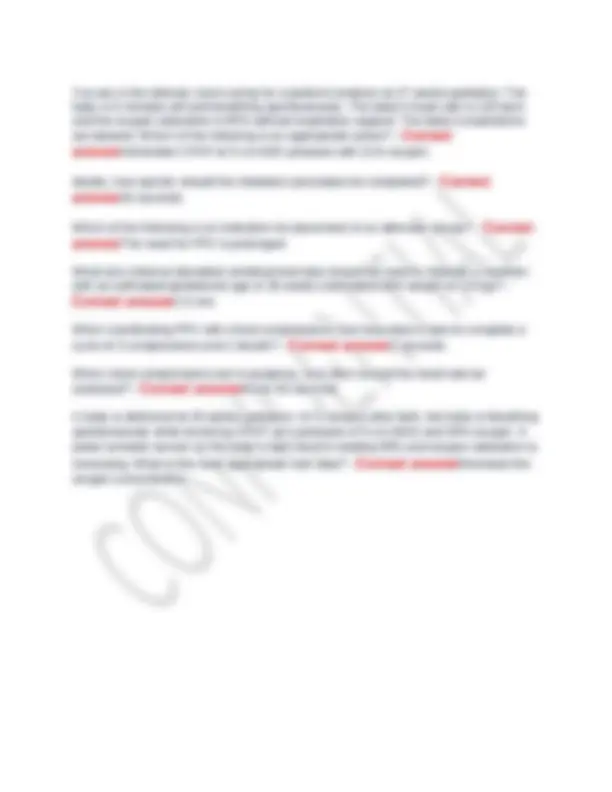




Study with the several resources on Docsity

Earn points by helping other students or get them with a premium plan


Prepare for your exams
Study with the several resources on Docsity

Earn points to download
Earn points by helping other students or get them with a premium plan
Community
Ask the community for help and clear up your study doubts
Discover the best universities in your country according to Docsity users
Free resources
Download our free guides on studying techniques, anxiety management strategies, and thesis advice from Docsity tutors
NRP 8th Edition Test Of 35 Complete Qestions And Answers Graded A_NRP 8th Edition Test Of 35 Complete Qestions And Answers Graded A_
Typology: Exams
1 / 4

This page cannot be seen from the preview
Don't miss anything!



NRP 8th Edition Test Of 35 Complete Qestions And Answers Graded A_ Your team has provided face-mask PPV with chest movement for 30 seconds. When is
baby's heart rate remains less than 100 bpm and is not increasing. During a delivery, when and where should a person with intubation skills be available? -
What are the primary methods of confirming endotracheal tube placement within the
rapidly increasing heart rate You are resuscitating a critically ill newborn whose heart rate is 20 bpm. The baby has been intubated and the endotracheal tube insertion depth is correct. You can see chest movement with PPV and hear bilateral breath sounds, but the colorimetric CO2 detector
output. According to the Textbook of Neonatal Resuscitation, 8th edition algorithm, at what point during resuscitation is a cardiac monitor recommended to assess the baby's heart
What size laryngoscope blade is recommended to intubate a preterm newborn with an
Even brief interruptions of chest compressions may significantly reduce their effectiveness, but it is also important to assess the need to continue chest compressions. What is the preferred way to assess the heart rate during chest
seconds to assess the heart rate using the cardiac monitor. Your team is resuscitating a newborn at birth. The heart rate is low and the baby has
remains less than 60 bpm after at least 30 seconds of PPV that moves the chest, preferably through an alternative airway
After 60 seconds of PPV coordinated with chest compressions, the cardiac monitor
of the anterior-posterior diameter of the chest
coordinate compressions and ventilations, the compressor calls out one-and-two-and- three-and-breathe-and.... Your team is resuscitating a newborn whose heart rate remains less than 60 bpm despite effective PPV and 60 seconds of chest compressions. You have administered epinephrine intravenously. According to the Textbook of Neonatal Resuscitation, 8th
According to the Textbook of Neonatal Resuscitation, 8th edition, what is the suggested
mg/kg (equal to 0.2 mL/kg) When is the administration of a volume expander indicated during newborn
signs of shock or a history of acute blood loss. Your team is caring for a term newborn whose heart rate is 50 bpm after receiving effective ventilation, chest compressions, and intravenous epinephrine administration. There is a history of acute blood loss around the time of delivery. You administer 10 mL/kg of normal saline (based on the newborn's estimated weight). At what rate should
How soon after administration of intravenous epinephrine should you pause
You are called to the birth of a newborn at 30 weeks gestation. As you prepare your equipment, what concentration of oxygen will you use initially if PPV is required? -
A baby is born at 26 weeks gestation. The initial steps of care, including gentle stimulation, have been completed and the baby is nearly 1-minute old. The baby is not
mask.
You are in the delivery room caring for a preterm newborn at 27 weeks gestation. The baby is 5 minutes old and breathing spontaneously. The baby's heart rate is 120 bpm and the oxygen saturation is 90% without respiratory support. The baby's respirations
What size (internal diameter) endotracheal tube should be used to intubate a newborn with an estimated gestational age of 26 weeks (estimated birth weight of 0.8 kg)? -
When coordinating PPV with chest compressions how long does it take to complete a
When chest compressions are in progress, how often should the heart rate be
A baby is delivered at 29 weeks gestation. At 5 minutes after birth, the baby is breathing spontaneously while receiving CPAP (at a pressure of 5 cm H2O) and 30% oxygen. A pulse oximeter sensor on the baby's right hand is reading 95% and oxygen saturation is
oxygen concentration.